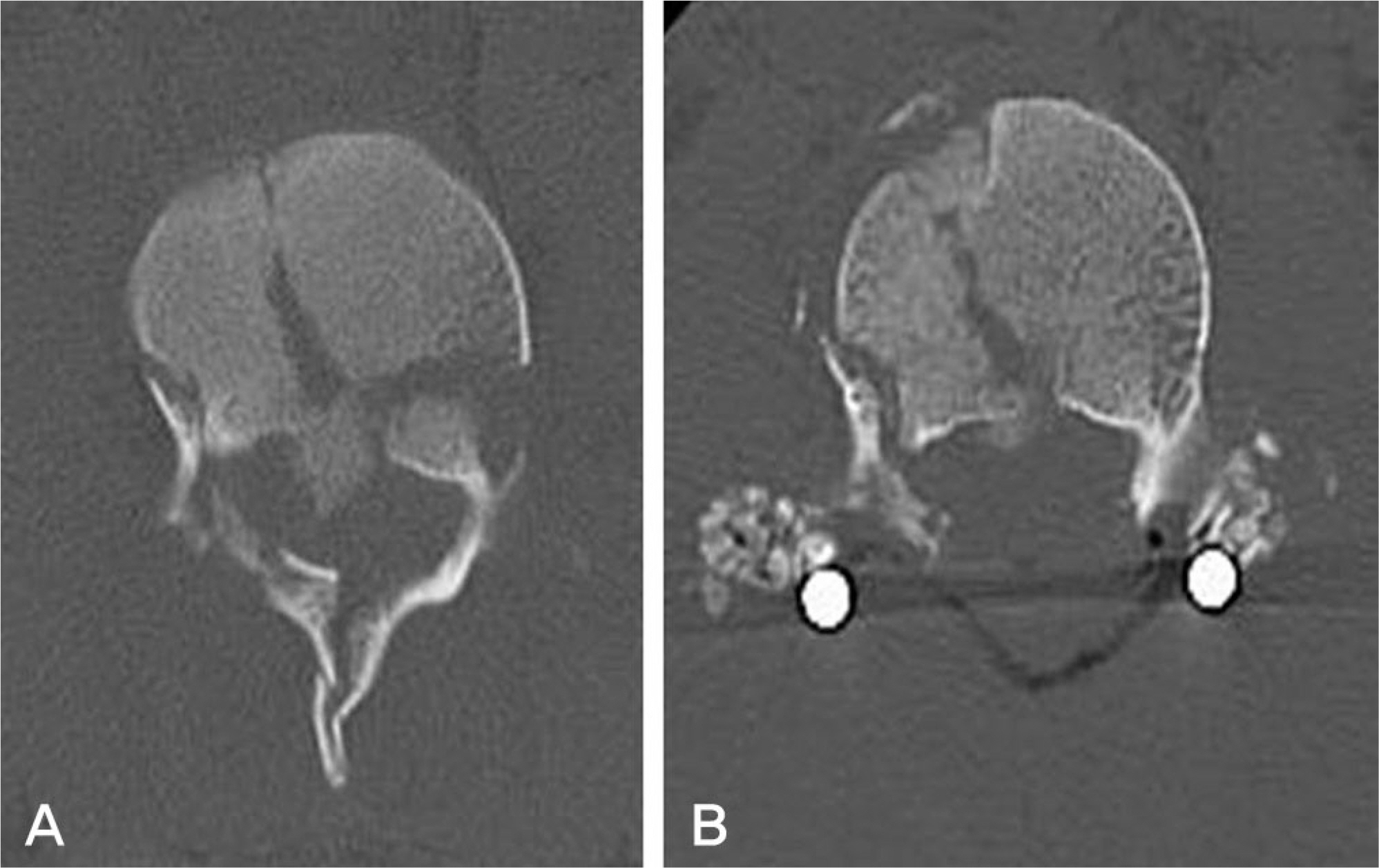J Korean Soc Spine Surg.
2010 Mar;17(1):7-12. 10.4184/jkss.2010.17.1.7.
Treatment Outcome of Lower Lumbar Fracture with Neurological Deficit
- Affiliations
-
- 1Department of Orthopedic Surgery, College of Medicine, Dong-A University, Busan, Korea. gylee@dau.ac.kr
- 2Department of Orthopedic Surgery, Dong-Eui Medical Center, Busan, Korea.
- KMID: 2003093
- DOI: http://doi.org/10.4184/jkss.2010.17.1.7
Abstract
- STUDY DESIGN: A retrospective study.
OBJECTIVES
To evaluate the clinical results of surgical treatment for a lower lumbar fracture with a neurological deficit. SUMMARY OF LITERATURE REVIEW: There are several methods for treating lower lumbar fractures with neurological deficits but no definitive guidelines have been established.
MATERIALS AND METHODS
From 2000 to 2008, this study reviewed 26 patients who had undergone surgery to treat a lower lumbar fracture with a neurological deficit and could be followed up for more than 12 months. The changes in the kyphotic angle, changes in the vertebral body height, compromise ratio of the spinal canal, recovery of neurological deficit, and clinical results were evaluated.
RESULTS
There were 15, 7 and 4 cases with a third, fourth and fifth lumbar fracture, respectively. There are 19, 2 and 5 cases of an unstable bursting fracture, chance fracture and translational injury, respectively. The compromise ratio of the spinal canal improved from 67.2+/-9.4% to 16.4+/-4.6%, and the changes in the kyphotic angle improved from 14.5+/-3.2degrees to 7.6+/-2.4degrees postoperatively and 9.7+/-4.3degrees at the last follow-up. The changes in the vertebral body height improved from 41.3+/-8.4% to 23.4+/-6.3% and the bone union rate was 92.3%. The neurological deficit recovered with 1.27degrees according to the Frankel classification and good functional results were obtained in 84.6% of cases.
CONCLUSIONS
Recovery of the neurological deficit and good clinical results were obtained with the recovery of the kyphotic angle and bone union with posterior decompression and instrumented posterolateral fusion in lower lumbar fractures with a neurological deficit.
MeSH Terms
Figure
Reference
-
1.Benson DR., Burkus JK., Montesano PX., Sutherland TB., McLain RF. Unstable throracolumbar and lumbar burst fracture treated with the AO fixateur interne. J Spinal Disord. 1992. 5:335–43.2.Esses SI., Boteford DJ., Kostuik JP. Evaluation of surgical treatment for burst fractures. Spine. 1990. 15:661–73.
Article3.Panjabi MM., Oxland TR., Lin RM., McGowen TW. Thoracolumbar burst fractures: A biomechanical investigation of its multidirectional flexibility. Spine. 1994. 19:578–85.4.Frankel HL., Hancock DO., Hyslop G, et al. The value of postural reduction in the initial management of closed injuries of the spine with paraplegia and tetraplegia. I. 1969. 7:179–92.
Article5.Denis F., Armstrong GWD., Serls K., Matta L. Acute thoracolumbar burst fractures in the absence of neurologic deficit. A comparison between operative and nonoperative treatment. Clin Orthop Relat Res. 1984. 189:142–9.
Article6.Levine AM., Edwards CC. Lower lumbar burst fractures: Reduction and stabilization using the modular spine fixation system. Orthopaedics. 1988. 11:1427–32.7.Levine AM. The surgical treatment of low lumbar fractures. Semin Spine Surg. 1990. 2:41–53.8.Finn CA., Stauffer ES. Burst fracture of the fifth lumbar vertebra. J Bone Joint Surg Am. 1992. 74:398–403.
Article9.Dai LY. Low lumbar spinal fractures: management options. Int J Care Injured. 2002. 33:579–82.
Article10.Shin DE., Cho DY., Kim JH., Kim JH. Relationships between canal occlusion and neurologic deficits, and between kyphotic deformities and fracture types in unstable thoracolumbar burst fractures. J Kor Spine Surg. 2006. 13:40–7.
Article11.White RJ. Pathology of spinal cord injury in experimental lesion. Clin Orthop. 1975. 112:16–26.12.Dickson JH., Harrington PR., Erwin WD. Harrington instrumentation in the fractured, unstable thoracic and lumbar spine. Tex Med. 1973. 69:91–8.13.Dickson JH., Harrington PR., Erwin WD. Results of reduction and stabilization of the fractured thoracic and lumbar spine. J Bone Joint Surg Am. 1978. 60:799–805.14.McAfee PC., Yuan HA., Laida NA. The unstable burst fracture. Spine. 1982. 7:365–73.
Article15.Benson DR., Burkus JK., Montesano PX., Sutherland TB., McLain RF. Unstable thoracolumbar and lumbar burst fractures treated with the AO fixateur interne. J Spinal Disord. 1992. 5:335–43.
Article16.Esses SI., Boteford DJ., Kostuik J. Evaluation of surgical treatment for burst fractures. Spine. 1990. 15:667–73.
Article17.Sasso RC., Cotler HB., Reuben JD. Posterior fixation of thoracic and lumbar spine fractures using DC plates and pedicle screws. Spine. 1991. 16:134–9.
Article18.Danisa OA., Shaffrey CI., Jane JA, et al. Surgical approaches for the correction of unstable thoracolumbar burst fractures: a retrospective ananlysis of treatment outcomes. J Neurosurg. 1995. 83:977–83.19.Viale GL., Silverstro C., Francaviglia N, et al. Transpedicular decompression and stabilization of burst fractures of the lumbar spine. Surg Neurol. 1993. 40:104–11.
Article20.Denis F., Burkus JK. Diagnosis and treatment of cauda equina entrapment in the vertical lamina fracture of lumbar burst fracture. Spine. 1991. 16:433–9.21.Cho KJ., Moon KH., Kim MG., Ko SM., Park HW., Park SR. Posterolateral decompression and posterior instrumentation in lumbar and thoracolumbar burst fracture with neurologic deficit. J Kor Spine Surg. 2000. 7:234–9.22.Tencer AF., Allen BL., Ferguson RL. A biomechanical study of thoracolumbar spinal fractures with bone in the canal. The effect of laminectomy. Spine. 1985. 10:580–5.23.Rodrigo AT., Osmar A. Spinal burst-type fracture on cauda equina area: correlation between neurological function and structural changes on spinal canal. J Orthop Surg. 2009. 17:261–4.24.Jeong ST., Cho SH., Song HR., Koo KH., Park HB., Chung UH. Comparison of short and long segment fusion in thoracic and lumbar fractures. J Kor Spine Surg. 1999. 6:73–80.
- Full Text Links
- Actions
-
Cited
- CITED
-
- Close
- Share
- Similar articles
-
- Fracture of the Cartilagenous End Plate of the Lower Lumbar Vertebral body: 3 Case Report
- Posterior Direct Decompression and Fusion of the Lower Thoracic and Lumbar Fractures with Neurological Deficit
- Recurrent Echinococcal Infection of the Lumbar Spine: An 11 Year Follow-up
- Crush-Cleavage Fracture in Thoracolumbar and Lumbar Spine: Comparative Study with Type B Burst Fracture
- Thracia and Lumbar Fracture: Classification According to Three Column Theory and its Relationship to Paralysis



